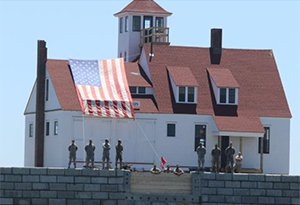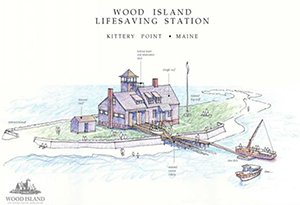R1 Success Story: Wood Island Life Saving Station, Kittery, Maine

Station restored building. (photo credit: WILSSA)
EPA Grant Recipient:
- Town of Kittery
- South Maine Planning and Development Commission
- Maine Department of Economic and Community Development
Grant Types:
- Assessment
- Revolving Loan Fund
- Cleanup
Former Uses:
U.S. Coast Guard Life Saving Station
Planned Use:
Maritime museum
Download Success Story:
Wood Island Life Saving Station, Kittery, Maine (pdf)
A small island off the coast of southern Maine that once hosted a lifesaving station is being brought back to life as a museum to maritime history. The Wood Island Museum will honor the early Coast Guard men who rowed out in terrible storms to save mariners in distress more than 100 years ago, providing a model for restoration that serves both the environment and the past.
Priming the Property for Redevelopment
The State of Maine gave the one-acre Wood Island to the federal government in the 1800s as a quarantine barrack. In 1908, the US Life Saving Service built a lifesaving station there to help maritime vessels in distress. From this station, the "surfmen" of Wood Island saved hundreds of lives in nearly 70 rescues. The station is one of 12 remaining buildings in the US built in the Duluth architectural style from Duluth, Minn.
In 1915, the Life Saving Service became part of the newly formed US Coast Guard, and in 1941, the US Navy took over the station to watch for attacks from Nazi submarines and protect the nearby Portsmouth Naval Shipyard. The Coast Guard returned to their duty at Wood Island after the war, but the station was decommissioned in 1948 and it remained unused for decades, slipping into poor condition.
The federal government transferred ownership of the island and station to the Town of Kittery in 1973. It remained unmaintained until 2009, when Kittery began to examine options for the derelict building. The Town partnered with the non-profit Wood Island Life Saving Station Association (WILSSA) to restore the station and island into a maritime museum. In 2015, the building was determined eligible for the National Register of Historic Places.
In 2010, the Southern Maine Planning and Development Commission provided $9,000 in EPA grant funds to assess the level of contamination at the station. The buildings were found to contain asbestos, bird waste, lead paint, and plaster debris. An underground storage tank was also found nearby.

(photo credit: WILSSA)
Clean-Up
The $6 million restoration, coordinated by Maine's Historic Preservation Office, sets a national example of public-private partnerships and sustainable restoration. The Town of Kittery received $200,000 in EPA funding for the cleanup in 2016. Additionally, Maine's Department of Economic and Community Development provided $58,000 from its EPA Brownfields Revolving Loan Fund program, the National Park Service provided a $200,000 National Maritime Heritage grant, and Maine's legislature voted to provide $200,000 for repairs.
Between 2018 and 2021, the Maine National Guard provided labor for construction through its "Innovative Readiness Training" program. In 2018, it trained 120 soldiers as they built the northern seawall, rebuilt the historic shed, and installed temporary electrical and plumbing systems. The sea wall was built two feet higher than the original wall to address rising sea levels. Other projects included restoring the southern sea wall and building ramps for handicapped visitors.

Today
"Without EPA's faith in our project, we never would have gotten started. This is an excellent example of the power of the Brownfields program. Thank you EPA!"
Sam Reid
WILSSA President
Recent additions to Wood Island include a new pier, a restored historic marine railway, and a rare eight-oared boat from the 1930s, called the Mervin Roberts, restored with a hidden electric engine that runs off solar panels on Wood Island. The off-grid electrical system combines a 12-kw diesel generator, mainly for winter use, with 2-kilowatt solar panels that can run the electricity the rest of the year. Wood Island's small on-site wastewater treatment plant, called the "Busse System," will recycle rainwater and wastewater using the building's 5,000-gallon cistern from 1908. This innovative closed-loop system involved special permitting from the Maine Department of Environmental Protection.
Between 2021 – 2023, WILSSA sponsored a wooden boat building class for 72 students from Traip Academy, the public high school in Kittery, all of whom received full academic credits while building two identical wooden replicas of the station's historic rowing boats. The new maritime museum is expected to open in 2024, with space for corporate events and overnight visitors. Plans are underway to allow daily visits from boat tour operators in Portsmouth, NH. Wood Island will be one of only a dozen historically restored life-saving stations open to the public, and organizers expect as many as 10,000 visitors each summer. The maritime museum will educate future generations about Wood Island's rich maritime history, the "surfmen" who risked their lives to save others, and the national importance of this life saving station.

For more information:
Visit the EPA Brownfields website at www.epa.gov/brownfields or contact Dorrie Paar, 617 617-918 -1432, [email protected].
EPA 901 A 18 003
October 2023
